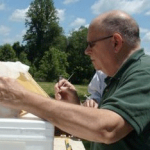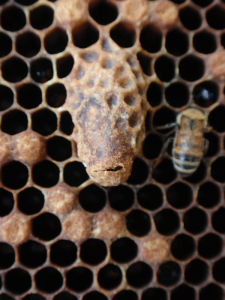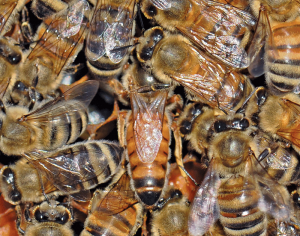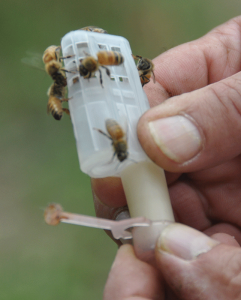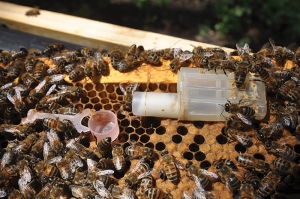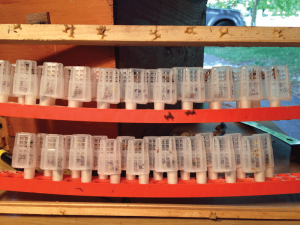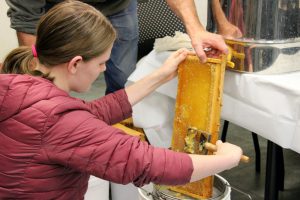By: Larry Connor
In Nature
In Nature, queen replacement is a family event. When a queen is being a replaced, the worker bees recognize the new queen as the daughter of their mother. In other words, the queen is a sister – sharing half of her genetic make-up with the workers. A portion of the workers are full sisters (often called super sisters) of the queen because they also share the same father. They are more closely related than the workers that have different fathers.
The three methods of queen replacement – supersedure, swarming and emergency replacement – use sisters as new queens. While the mechanism or motivation of queen replacement vary with these methods, the result in Nature is the same – the new queen is genetically related to the workers.
Queen Detection
This all links to the workers’ detection of a new queen, and how they respond to her. Workers respond to their sister queen from the time the queen is deposited in a queen cup (making it a queen cell), and at every stage of the queen’s development. Here is a step-by-step summary of this activity:
Egg in queen cup – Since the egg in the cell is apparently the same as an egg in a worker cell, we conclude that the queen factors attracting bees and causing feeding behavior is triggered by the size, shape and position of the queen cup.
Larva in queen cell – Once the egg hatches, the bees feed her a diet of royal jelly. Wait a minute, during the first 48 to 50 hours of a worker and drone bee’s life, they are also fed royal jelly! Thus the food must not be the initial trigger for queen recognition. It must be the size, shape and position of the queen cup, the same as the egg. There is strong evidence that the queen larva receives more food during the first two days of feeding than the worker. She also is living in a cell that is built into a queen cell. The trigger is there to develop this sister into a queen.
As the cell grows, the worker bees respect it. The cell inserts or hangs in the ‘sacred’ bee space, and if it was anything else it would be torn down, retrofitted or covered with wax and propolis.
As the queen pre-pupae (the last stage of larval development) and the pupae mature, the bees start to detect small amounts of queen pheromone (queen substance).
There is often competition between developing queen cells, especially in emergency response queen cells. A colony may start many queen cells, but will eventually trim (destroy) the numbers to a dozen or more queen cells. Possible explanations for elimination of these developing cells include: genetically defective queen larva/pupa, lack of relatedness to the majority of worker bees, poor feeding, and bad location on the comb. Few beekeepers can predict which cells the bees will destroy and which they will continue with development. Random ‘luck’ or the lack of it may be a larger factor than we realize. Developing queens cannot go back to being worker bees once the process begins.
Mature queen cells, a term we use to describe cells within 24 hours of emergence, are very attractive to worker bees. Sometimes they remove the wax covering off the tip of the cell and expose the silk cocoon underneath. It is thought that the workers are making close contact or inspection of the queen’s pheromone production. So, even before a queen emerges, the pupa produces a simple queen pheromone signature that workers use to recognize the cell, and later on, the newly emerged queen.
Newly emerged queen – I enjoy watching queens emerge from their cells. They often crawl out of the cell and walk to an open cell of honey and take a long drink. Or they will be fed by worker bees. They are clearly recognized as a queen but at a lower level than when she is a year old. Young queens immediately start searching the hive for their same-age sister queens and queen cells in order to kill them.
12-hour old queen – Queens seem to experience an increase in pheromone production once they hit the first half day of their life. From this point on, the queen must be handled as a queen, and provided with a proper delay in introduction. We will discuss this below.
Newly mated queen – After successful mating, queens produce egg-laying hormones that correlates with an increase in the production of new queen pheromones. These additional chemicals continue to be added as the queen ages.
Year-old queen – At the one-year mark, queens seem to be at their peak queen pheromone production level. This correlates with their period of maximum output as a queen, laying one to two thousand eggs per day during the peak season.
Failing queens – Along with a reduction in egg-laying rate, failing queens (regardless of age) appear to experience a reduction or change in their queen pheromone production. I suspect the two are related, as anytime we see a colony with about half of the brood of surrounding colonies, we often see, or will see, developing supercedure cells.
What this means to the beekeeper
Unrelated stocks are hard to requeen while genetically related stocks are easier to requeen. Unrelated bee stocks will experience a lower queen introduction rate, lower longevity of the queens (as seen in early supersedure) and other problems. When I ran the Starline program in the 1970s, one of the inbred lines – the F line – was of a Carniolan origin while the other three inbred lines used in the four-way hybrid were developed from Italian colonies. When we raised drones from the F line, we had to introduce new queens into colonies that carried that F line in their pedigree. Otherwise we experienced poor queen acceptance and early queen replacement.
Today we have heard stories about beekeepers experiencing difficulty introducing certain queen lines into their hives or nuclei. One that receives a great deal of attention is the Russian strain released by USDA and maintained by a bee breeder cooperative.
Time – Regardless of the age of the queen, take your time during queen introduction. For same-race queens you can easily use a three to five day delay in the introduction process, while for different-race queens you should use a five to seven day delay before the new queen is allowed to emerge from a queen cage. This often means you, as beekeeper, need to make a return visit to remove the cork or plug from the candy end of the queen cage.
Young workers – As you set up colonies for queen introduction, make sure they are filled with emerging worker bees, so the new queen has a large number of ‘naive’ workers – those that have never been adult bees in the presence of another queen – to care for the new queen and help her grow the colony. This is especially true when you are building nuclei or increase colonies. Use the Doolittle method or another method to ensure that you have plenty of young bees in your new colony.
Incoming food – Make sure that colonies being requeened (or packages with a new queen being released) are well fed and are receiving supplemental sugar syrup to increase the acceptability of the queen. Why is this important? We know that bees share a community stomach, sharing food with one another. During this feeding process they are also sharing the odor of the queen. When you put a new queen into a cage and leave her between two frames of brood, do not expect all the worker bees to walk over to the queen cage and get their allotment of queen pheromone. The bees use a smaller number of worker bees to serve as the queen’s retinue (attendants), and the identity of these bees continually changes. After a worker has fed or groomed the queen, she will walk out onto the comb and spread the odor of the queen, not unlike the human who has been exposed to high levels of radiation and exposes others as she walks away from the location of exposure. Queen pheromones are not radioactive, thankfully, but the impact on the colony is highly significant to colony success and queen acceptance. The presence of a jar/can/feeder of syrup will greatly increase queen introduction success. Yes, even during a nectar flow.
This is why it is so hard to introduce queens during a dearth, a period when there is no food for the bees to gather. Most experts recommend that you not introduce queens during a dearth, and if you must, feed the colonies starting a week in advance so they are strong and well fed. More important, they are sharing food and will quickly share the new queen’s pheromone.
Why queens in package colonies often fail
If you must purchase package bees (and this is often the only option for new beekeepers), keep in mind a few facts about the queen in the package you purchase:
The queen is not related to the bees. This is not the mother of these bees. At best, she has been a queen of a small mating nucleus for the matter of a few days before she was removed and added to a two to four-pound box-o-bees shaken from colonies located miles away.
The queen is young, and has not developed her full set of pheromones. She has produced a few hundred to a few thousand eggs before she was picked out of a mating nucleus and sent to you.
The queen introduction cage has a candy plug that may be removed to liberate the queen. Keep the candy plug or cork in place for three to five days after you set up the colony. This allows the bees time to spread her pheromone throughout the colony. Yes, I know the colony is small. Delay her release.
Feed the colony. As we just discussed, feeding increases pheromone communication between the queen and her new bees.
Why purchased queens often fail
Many beekeepers use queen cells, virgin queens and mated queens with tremendous success, between 95 and 99% acceptance. At other times, beekeepers experience a very low acceptance rate. Here are a few factors that may contribute to queen introduction failure:
The queen may be very different from the bees in the hive, and they may be difficult to requeen. Increase the time the queen is in the cage and make sure the colony is well fed during the requeening process.
The queen has been in-transit, either in a queen cage with a few workers or in a battery box with a larger number of bees. When a queen is surrounded by four to six worker bees, she is not being well fed because the workers are not being well fed. The cage probably has a small amount of queen candy (sugar and water) and is designed to keep the bees alive. Once you receive your queens, give them all the honey they can consume (in small amounts, not a bath) and water. These bees are dehydrated.
Queens in transit are sometimes subjected to hot, dry conditions and will never recover. This is a risk of shipping queens.
Off season queens are often stored and then removed from queen banks, and have lost a great deal of weight. Their ovaries are shrunken and they are not producing much pheromone. Feed and hold for a full week before releasing.
Read more about queen handling and requeening in the following publications:
Flottum: The Backyard Beekeeper, 3rd Edition
Connor: Queen Rearing Essentials, 2nd Edition
Connor: Increase Essentials, 2nd Edition, Using the Doolittle Concept and Chapter 9 Queen Care
Dr. Connor is teaching queen rearing classes in several locations this season. Check it out in www.wicwas.com.






